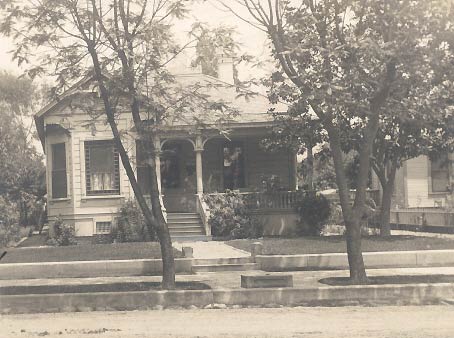
A Visit to Old Los
Angeles
14. Hope Street and Flower
Street.
by
Brent C. Dickerson
Copyright © Brent C. Dickerson
Index to Episodes (click here)
• Hope Street! "I should like to live on Hope," sighed Anna. Mother thought a moment, and said, "It's my opinion that that's what we all do live on, child." No different from its neighboring Bunker Hill streets in the low hundreds, Hope Street sports older residences, sometimes modest, sometimes proud, but always beloved, I think. Note the mounting stone at curb's edge.

• As with hope itself sometimes, views of Hope Street are elusive; again as with hope itself, we take what scraps we can find. Here is a much enlarged, and thus blurry, view of the area of the corner of 3rd Street and Hope Street; Hope is the street we see going diagonally at upper left. Dominating in the lower foreground, our old friend the Granada on Grand Avenue obtrudes upon our view.
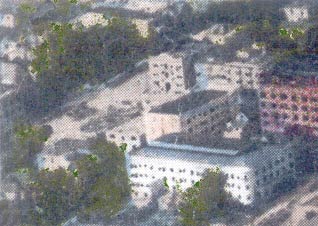
• At least since 1906, there had been an apartment house at 407 S. Hope Street. Formerly the Briggs Apartments, by 1928 it was christened the Barbara Worth Apartments, evidently after the heroine of the popular 1926 Western starring Ronald Colman, Vilma Banky, and Gary Cooper.
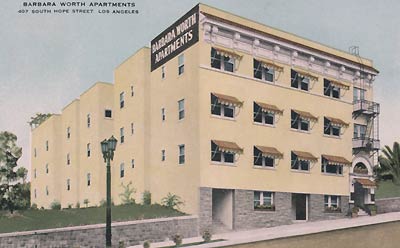
• In August, 1903, one William Wyles obtained a building permit in order to construct a "three-story frame apartment house of seventy-four rooms, to cost $18,000" at 433 S. Hope Street. This would be the Santa Barbara Apartments. The original owner of the postcard view wrote on the reverse that this is a view of "Daddy and Me in our 1st Apt. on So. Hope St. L.A. after we married"; but neither Daddy nor Me seems to be in evidence.
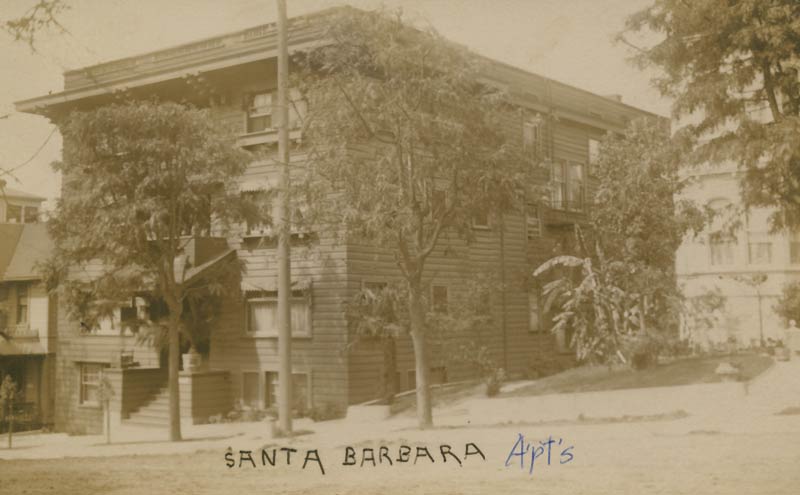
| • The Touraine Apartment House is at address 440 S. Hope Street. The severely classical architecture is softened by the rooftop patio. | 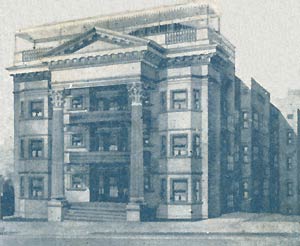 |
• From next to the Normal School, we see a tiny bit of the west face of Hope's 400s block off to the left of the Engstrum Hotel Apartments featured in this view. The Engstrum building is on Fifth Street, facing south to the State Normal School site, between Grand Avenue and Hope Street.
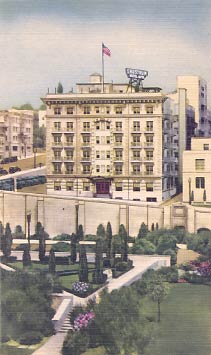
• A card young FJ nabbed from the lobby indicated that the Engstrum was "Los Angeles' Fashionable Downtown Apartment Hotel. Absolutely fireproof, new, roof garden, sun parlor, ballroom, gentlemen's club room, beautiful lobby. Perfect ventilating, steam beating ["It says 'heating,' not 'beating'," admonished young FJ], and filtered water systems throughout. Perfect hotel service. NO EXTRA CHARGE for washing dishes, daily cleaning of apartment, telephones, gas, electricity, or use of ballroom. Downtown, yet away from the noise." "Think of all the ways one could use the ballroom—and no charge," mused young FJ; "Baseball, for instance. What could be more appropriate in a ballroom than a ball game? And . . ." Minnie sighed, "I am downtown, and at the Engstrum, and yet I am not away from the noise." "Someday you will have children, Minnie," said Mother.
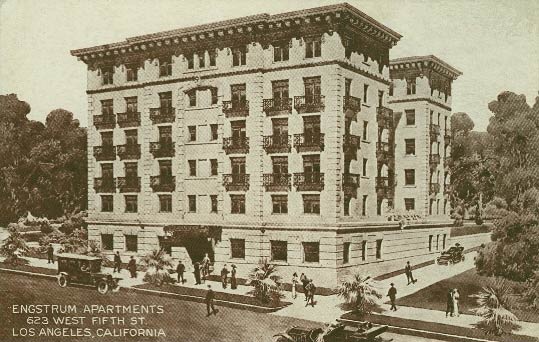
• The next morning, quiet stepsister Anna sought out Papa, and found him alone, enjoying a cigar out on Aunt Sigrid's porch. "Oh, Papa—I dreamt such wild things last night. I thought I was a bird, and flew over what seemed to be where we strolled yesterday; but different buildings were there, and such big ones, and closing in the little streets, and I was happy I was a bird, to fly higher and higher . . . until . . . until I saw I was all alone . . . and the I couldn't breathe any more . . . " "Come hug Papa, my dear girl," was all Papa could say. Anna saw a few decades into the future: Central Park was still there, as Pershing Square—the California Club and Auditorium, too—but the Biltmore Hotel has replaced the churches and miscellaneous buildings on its near side (the west side); while, closer yet, the Normal School has been demolished, its hill lowered, and the central library (the white building in the foreground with the pyramidal peak to its tower) constructed there. The first building directly to the left of the library tower in this view is the Engstrum Hotel Apartments, seen from another angle in the previous view.Going right and left from the middle of the library building, we see the interrupted Hope Street and (in the lower right corner) its intersection with Sixth Street.
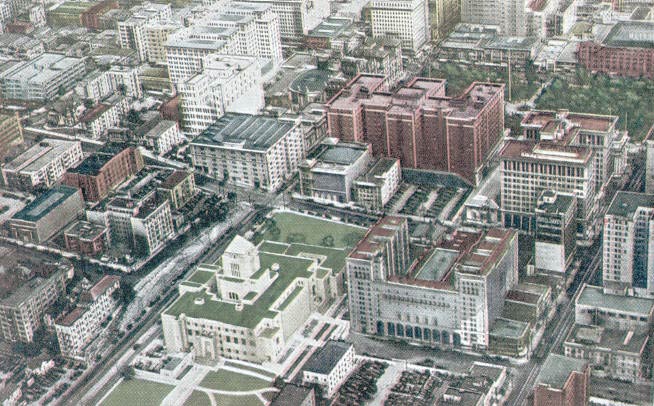
• Where a moment ago we saw a grassy, tree-studded slope beneath the Normal School, we now find the Bible Institute of Los Angeles—the east side of the high 500s of Hope Street. For many years, though long after our family's visit, large signs stating JESUS SAVES, atop the building's towers, were a prominent feature of the downtown skyline.
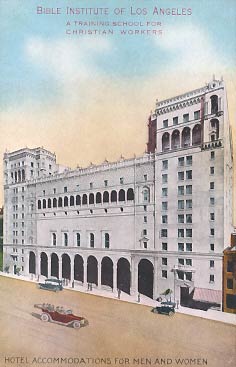
• At 633 S. Hope Street could be found the convivial Ye Bull Pen Inn. (Ye Bull Pen Inn subsequently moved into the Mayflower Hotel at 535 S. Grand Avenue.)
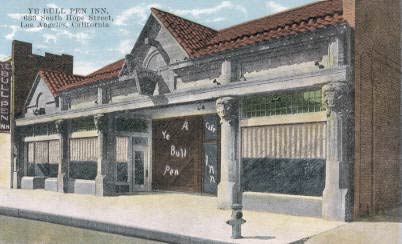
• We all stepped inside for a snack. Minnie sighed, "The ambience—'tis a bit countrified, I must say." Mother looked around, and took a breath. Young Frederick Johan whispered to me, "I know what she's going to say." "As if I didn't," I whispered back. Quoth Mother, "It is at times like this that I am reminded how glad I am that cows can't fly." "Would you like to change seats?", asked Anna.
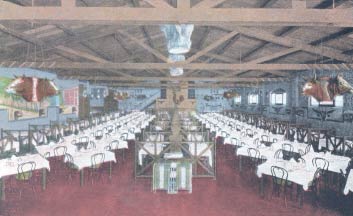
| • Across the
street at 616 S. Hope Street could be found the University Club; the
building had its formal opening July 6, 1922—"which means that we're
looking about 16 years into the future," calculated young Frederick Johan.
"Nobody likes a bean-counter," said Charley. | 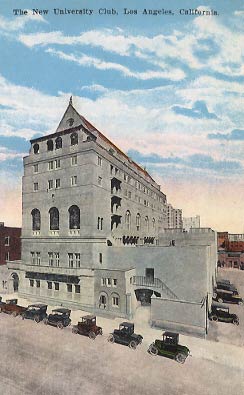 |
• On the south side of Seventh Street, between Hope Street and Grand Avenue, is the J.W. Robinson Department Store, the Grand Avenue side of which we saw, under a very blue sky, during our stroll down Grand. Mr. Robinson had also started the Boston Store, which we saw dressed up for the 4th of July back on Broadway; this was a new and larger enterprise. Hope Street goes off to the right in the foreground; at the right margin of this image, you can see just a bit of the Simpson Auditorium, of which we'll get a closer look in a moment; Seventh's corner with Grand is in the distance.
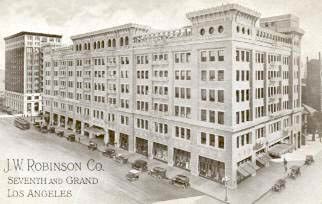
• Across the street on Hope is the Y.M.C.A., at 715-729 S. Hope Street.
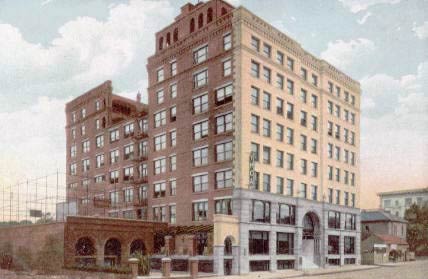
• Let's step inside, shall we? We left the ladies and the baby in the lobby.
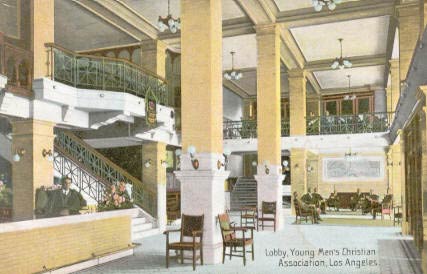
• The rooms are modest, but comfortable.
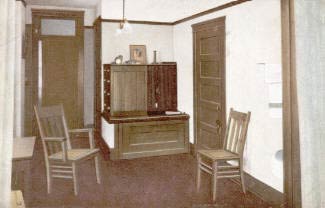
• But the center of activity is the gym!
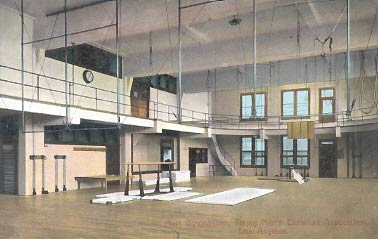
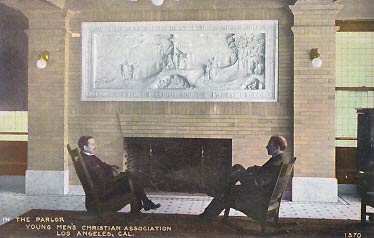 |
• Charley and I sat in the parlor for a moment. "It
seems supernaturally quiet here," I said. Charley sighed, "Minnie is in
another room." |
• We couldn't go in in our street clothes to see the pool; but young Frederick Johan picked up this postcard of it. "Well, I guess they didn't want you to slip in and fall to the bottom," Papa said to him that night; "your body might clog up the drain when they go to clean it."
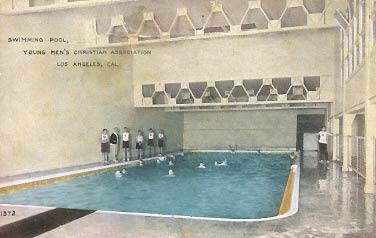
• It was relaxing there, whether watching the young gentlemen going through their physical regimens in the gym, or elsewhere in the tidy and orderly building. Charley, however, was rushing us along to leave; "I don't like being anywhere where the men are all in much better shape than I am. After all, what if some sweet young girl would happen to come along?", he said as we passed out through the lobby back to the street. "I doubt very much that some sweet young girl would happen to 'come along' in the men's gymnasium," said I. Charley looked a bit abashed; "still," he said, "it's the principle of the thing."
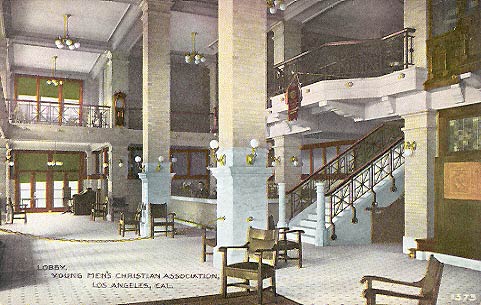
 | • Back across the street, on the J.W. Robinson's side of Hope, halfway down the block, is Simpson Auditorium, known also as Simpson Tabernacle, which opened in December of 1889. |
• As we neared the First Congregational Church on Hope, across the street on the west side of Hope again, near its corner with Eighth Street, Mother declared that, what with churches, tabernacles, Christian Associations, schools, and other such what-not, this was a positively inspiring part of town. "It certainly seems to inspire a reverential silence from Minnie," quoth young Frederick Johan. Minnie sighed, "I'm much inspired by the young men I see walking towards the Y.M.C.A." "Pious thoughts, Minnie . . . pious thoughts . . . ," I said. "My thoughts are certainly pious at the moment," Papa announced; "Sigrid said that she'd have an apple pie ready for us when we got back." Mother shook her head sadly, patted the baby, and said, "All of this should teach you Fortitude."
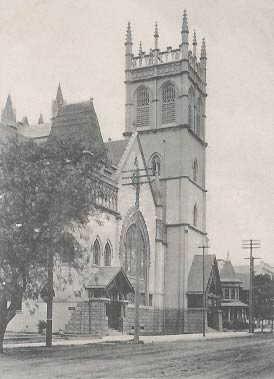
• At the corner of Eighth and Hope Streets was the Morgan Hotel. In 1929, the Panamanian Consulate could be found in the hotel's room 104.
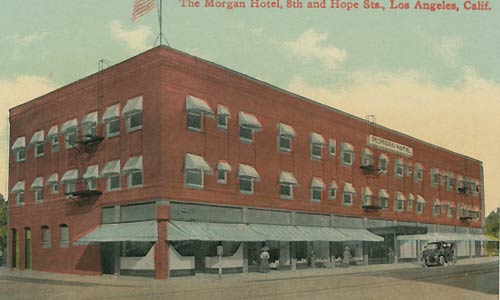
• The first time Mother saw this wonderful edifice, at the northeast corner of Hope and Ninth Sts., she scandalized Aunt Sigrid by saying, "Oh, is this another train station?". Aunt Sigrid clapped her hand to her forehead, and said, "Oh, good gracious, no! This is our beautiful local Jewish temple—the B'nai Brith temple. The Jews are very dynamic in civic improvement here—always have been, practically back to pueblo days." Trinity Auditorium, which we saw back on Grand Avenue, is just around the corner.
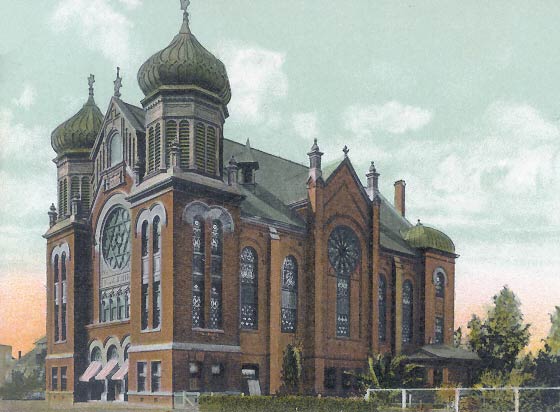
• Continuing south along Hope, we passed the Scottish Rite Cathedral at 929 S. Hope Street.
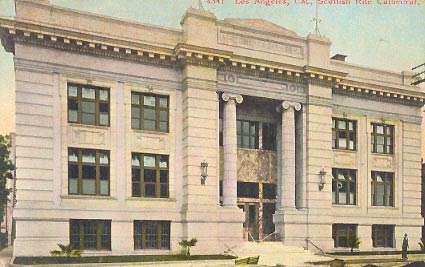
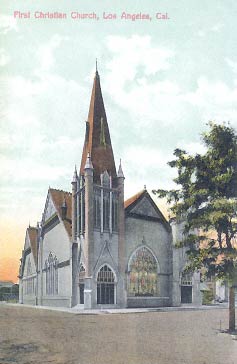 | • Yet another church rose above us at Eleventh and Hope Sts. This is the First Christian Church, built in 1897. |
• Aunt Sigrid's place was a little south of downtown, near Hope and 12th Sts. Young Frederick Johan had this postcard made of Aunt Sigrid standing in front of her house. There is a canary in a birdcage just inside the front window, with her old piano Erasmus between it and the door. I think I wrote earlier, dear, that Aunt Sigrid used to be a singer and actress all through the West, carting this self-same piano with her, same time that Papa and his brother were working all up and down the Mississippi? Anyhow, we are having many a merry evening in the parlor, gathered around that piano.
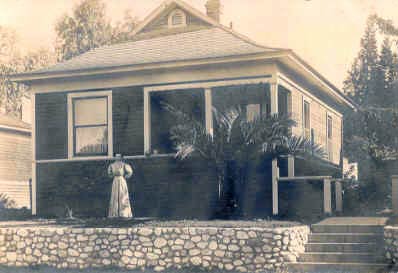
• Like its neighboring streets Grand and Hope, Flower was largely residential, especially in the lower hundreds. Pictures are more than scarce—we must go all the way to Sixth Street before we find something to show you! The stately Hotel Snow presides over the corner of Flower Street and Sixth Street.
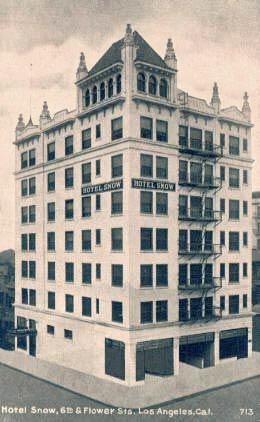
• Just steps from the Hotel Snow, we find the Seminole Apartments at 620 S. Flower Street. Anna gazed up at its sign, blinked twice, pursed her lips, and said, "Odd, isn't it, how you can see the sky right through the sign..." Mother sighed heavily, adding, in due course, "There are times—particular times, hear me say—at which I feel that legs are being pulled. I'm not sure if it is right legs or left legs, mind you, but legs are being pulled." "One's dresses wouldn't fit properly afterwards," Minnie fretted; "just think of all the ankle!" "They would if they snapped right back," I said; "legs are not taffy, you know." At this, the Baby screwed up his face and began to wave his arms. "Oh," said Anna, "let's do take him inside; I'm sure he doesn't want his complexion spoiled by the sun." Papa, who was hanging back a bit with Charley and young FJ, hesitated a moment, and then said, "Once upon a time, yes, once upon a time, Charley, long ago it was, I was running a family of lunatics up the river from one town to another—it seems that they all went mad sort of in concert you might say when half of them were eaten by a bear..." "Was it the upper halves or the lower halves eaten?", enquired FJ. "No, I do think it was their older halves, with a fat little young'un as a sort of dessert, as I took it. Well, anyhow, you see, as we beat along up the river, I listened to them babble and rave when I had spare moments; and..." Mother turned around and squinted at him. "Just what might you be driving at, Mr. S.?" Papa took a long draw on his cigar, looked into the distance, puffed out the smoke slowly—it made a perfect ball—and said, "Mrs. S., I do think that the sun sparkled that day just as prettily it is doing right now."
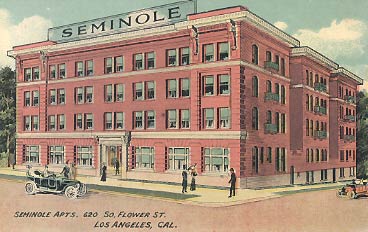
• And here is the Seminole's lobby, resplendent in Kentia Palms and brass-potted Aspidistras. "In college, I learned a song about Aspidistras!" cried Charley; however, on a sharp look from Mother, he added, "—but I forget how it goes . . . "
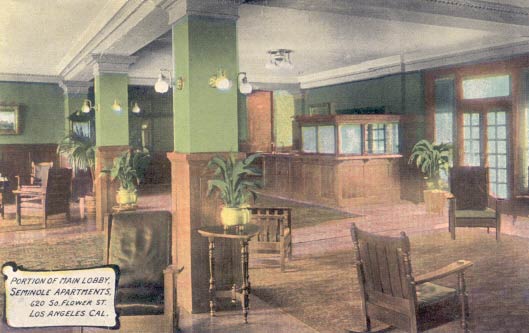
| • The clerk at the desk glanced at Charley and said, "The Ladies' Parlor is upstairs, 'round the corner." When Charley looked at him blankly, the clerk repeated, rather sternly, "Upstairs, round the corner!" With a shrug—and a bit of a smile—Charley bolted upstairs, and presumably 'round the corner. Minnie was overcome with curiosity—it's easy to tell, because she starts digging with her tongue at a hollow in her tooth—strutted over to the desk, and said, "Pardon me, but why did you just send my brother to the Ladies' Parlor?" Now it was the clerk's turn to look blank. "Isn't he Peabody Snitt, Drawing-Room Poet?" "Sir, he may well be a poet in the drawing-room in his own way, but he certainly isn't Peabody Snitt, nor any other kind of Snitt." "Aye, that he isn't!" came a voice from the door—the unpleasant little Scotsman we had encountered in the lobby of the Hotel Stowell on Spring Street, "and that I am!" Charley was soon ejected from the parlor, much to his chagrin. | 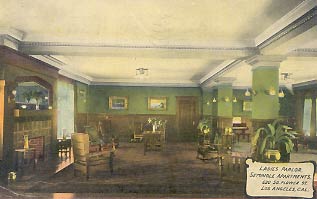 |
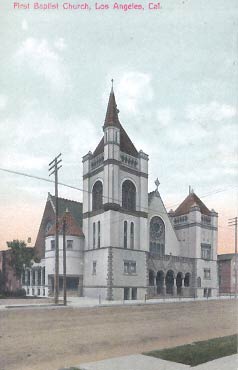 | • Back to churches! The First Baptist Church was to be found on the west side of Flower Street midway between Seventh and Eighth Streets. |
• Dear, as you might imagine, we became very familiar with the northwest corner of Flower and Eighth Sts. I can hear you saying right now in your liquid tones—in truth, I'm not sure what a "liquid tone" might be, but surely if it's a good thing, you have it in abundance!—I can hear you saying, "Why might that be, Ulf?" Well! This was our local Lutheran church—called the First English Lutheran Church; and we trooped off there every Sunday. Minnie confided to me that she much preferred the services back home in Swedish, as since she can barely understand two sentences in a row of Swedish, she could doze without any fear of having missed anything. I pointed out that a person could doze through English as well; but she gave me a look which stopped me flat. Note the trees off to the left in this picture; they're on the south side of Eighth Street . . .
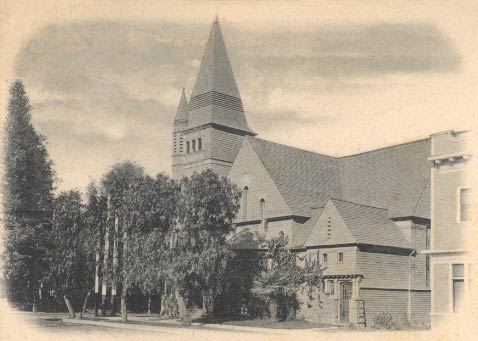
• This place of worship had also been known as the First German Lutheran Church; we see it here from another angle, from the southeast. Eighth Street goes off west to the left; Flower Street, north to the right.
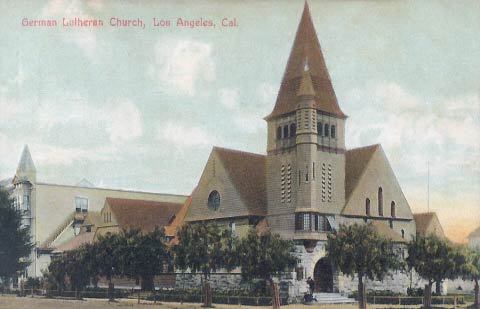
• This view shows what replaced those trees across the street from the church: the rather modest Hotel Congress, at the southwest corner of Eighth Street and Flower Street. "What it lacks in extravagance," said Mother, "the church across the street supplies in honor." "No doubt," said Charley.
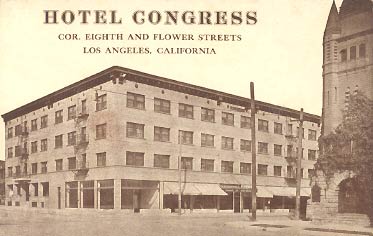
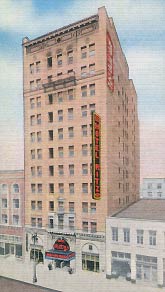 |
• Not to be totally defeated, however, by the paucity of postcards showing Flower Street, the ingenious Frederick Johan did manage to find a card showing a view from about the corner of Flower Street and Seventh Street, looking northeast over the city. "At least," quoth he, "close enough." We see the greenery of Central Park at the center; and from there we can easily pick out the Auditorium; and we see the back of the Wright-Callender Building rising beyond the Auditorium; we can see a few yards of Grand Avenue as it approaches Seventh Street at the lower right-hand corner of the view (the State Normal School is just out of view to the left); the buildings on Bunker Hill rise at the left to look down over the city; and, deep in the picture, off towards the right, we can see the Braly Building back at Spring and Fourth rising from the flatlands to meet Bunker Hill's gaze—all in all, a wide swath of downtown Los Angeles!
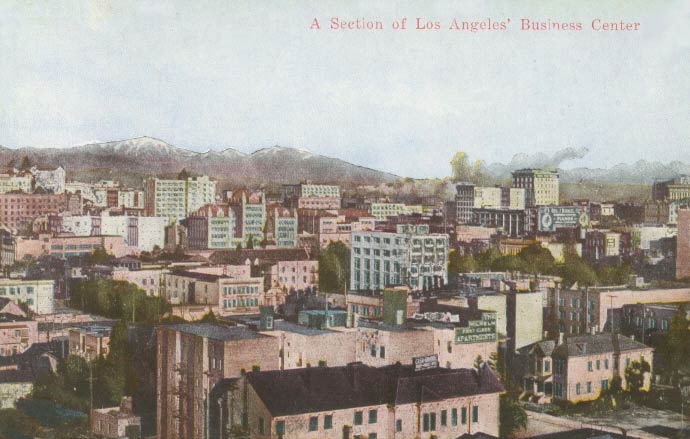
Return to Grand Avenue; or on to Figueroa Street . . .